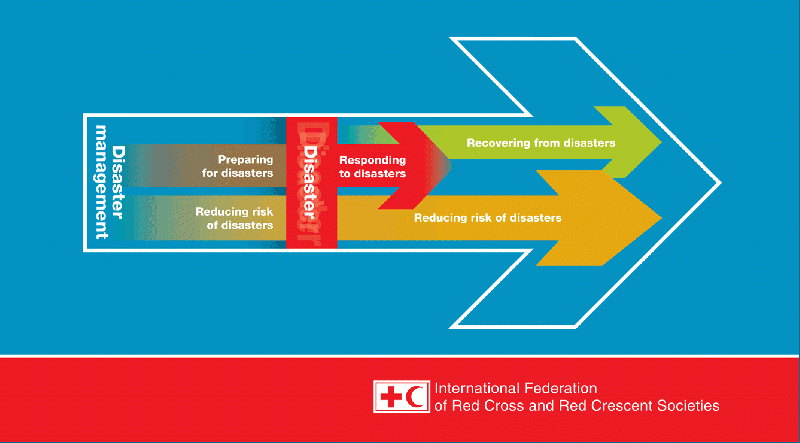Disaster Management
Original Editor - Naomi O'Reilly
Top Contributors - Naomi O'Reilly, Tony Lowe, Kim Jackson, Admin, Vidya Acharya, Rachael Lowe, Tarina van der Stockt, WikiSysop, Laura Ritchie, Jess Bell and Selena Horner
Introduction[edit | edit source]
Disaster, as defined by the United Nations, is a serious disruption of the functioning of a community or society, which involve widespread human, material, economic or environmental impacts that exceed the ability of the affected community or society to cope using its own resources. Disaster management is how we deal with the human, material, economic or environmental impacts of said disaster, it is the process of how we “prepare for, respond to and learn from the effects of major failures” [1]. Though often caused by nature, disasters can have human origins. According to the International Federation of Red Cross & Red Crescent Socities a disaster occurs when a hazard impacts on vulnerable people. The combination of hazards, vulnerability and inability to reduce the potential negative consequences of risk results in disaster [2].
(VULNERABILITY+ HAZARD ) / CAPACITY = DISASTER [3]
Natural disasters and armed conflict have marked human existence throughout history and have always caused peaks in mortality and morbidity. This article examines the advances in the humanitarian response to public health over the past fifty years and the challenges currently faced in managing natural disasters and armed conflict [4].
Types of Disaster[edit | edit source]
Natural Disasters[edit | edit source]
According to the International Federation of Red Cross & Red Crescent Societies Natural Disasters are naturally occurring physical phenomena caused either by rapid or slow onset events that have immediate impacts on human health and secondary impacts causing further death and suffering. These disasters can be [5]:
- Geophysical (e.g. Earthquakes, Landslides, Tsunamis and Volcanic Activity)
- Hydrological (e.g. Avalanches and Floods)
- Climatological (e.g. Extreme Temperatures, Drought and Wildfires)
- Meteorological (e.g. Cyclones and Storms/Wave Surges)
- Biological (e.g. Disease Epidemics and Insect/Animal Plagues)
The United Nations Office for Disaster Risk Reduction characterise Natural Disasters in relation to their magnitude or intensity, speed of onset, duration, and area of extent e.g. Earthquakes have short durations and usually affect a relatively small region, whereas Droughts are slow to develop and fade away and often affect large regions [6].
Man-Made Disasters[edit | edit source]
Man-Made Disasters as viewed by the International Federation of Red Cross & Red Crescent Societies are events that are caused by humans which occur in or close to human settlements often caused as a reults of Environmental or Technological Emergencies. This can include:
- Environmental Degradation
- Pollution
- Accidents (e.g. Industrial, Technological and Transport usually involving the production, use or transport of hazorous materials)
Complex Emergencies[edit | edit source]
Some disasters can result from multiple hazzards, or, more often, to a complex combination of both Natural and Man-made causes which involve a break-down of authority, looting and attacks on strategic installations, including conflict situations and war. These can include [7]:
- Food Insecurity
- Epidemics
- Armed Conflicts
- Displaced Populations
According to ICRC these Complex Emergencies are typically characterized by [8]:
- Extensive Violence
- Displacements of Populations
- Loss of Life
- Widespread Damage to both Societies and Economies
- Need for Large-scale, Humanitarian Assistance across Multiple Agencies
- Political and Military Constraints which impact or prevent Humanatarian Assistance
- Increased Security Risks for Humanitarian Relief Workers
Pandemic Emergencies[edit | edit source]
Pandemic (from Greek πᾶν pan "all" and δῆμος demos "people") is an epidemic of infectious disease that has spread across a large region, which can occur to the human population or animal population and may affect health, disrupts services leading to economic and social costs. It may be an unusual or unexpected increase in the number of cases of an infectious disease which already exists in a certain region or population or can also refer to the appearance of a significant number of cases of an infectious disease in a region or population that is usually free from that disease. Pandemic Emergencies may occur as a consequenceof Natural or Man-Made Disasters. These have included the following Epidemics:[9] [10]
Aspects of Disaster Management[edit | edit source]
The International Federation of Red Cross & Red Crescent Societies defines disaster management as the organisation and management of resources and responsibilities for dealing with all the humanitarian aspects of emergencies, in particular preparedness, response and recovery in order to lessen the impact of disasters.
Disaster Prevention
[edit | edit source]
"The outright avoidance of adverse impacts of hazards and related disasters"
Comment: Prevention (i.e. disaster prevention) expresses the concept and intention to completely avoid potential adverse impacts through action taken in advance.
These are activities designed to provide permanent protection from disasters. Not all disasters, particularly natural disasters, can be prevented, but the risk of loss of life and injury can be mitigated with good evacuation plans, environmental planning and design standards. In January 2005, 168 Governments adopted a 10-year global plan for natural disaster risk reduction called the Hyogo Framework. It offers guiding principles, priorities for action, and practical means for achieving disaster resilience for vulnerable communities.
Disaster Preparedness[edit | edit source]
Disaster preparedness refers to measures taken to prepare for and reduce the effects of disasters. That is, to predict and, where possible, prevent disasters, mitigate their impact on vulnerable populations, and respond to and effectively cope with their consequences.
Disaster preparedness provides a platform to design effective, realistic and coordinated planning, reduces duplication of efforts and increase the overall effectiveness of National Societies, household and community members disaster preparedness and response efforts. Disaster preparedness activities embedded with risk reduction measures can prevent disaster situations and also result in saving maximum lives and livelihoods during any disaster situation, enabling the affected population to get back to normalcy within a short time period.
These activities are designed to minimise loss of life and damage – for example by removing people and property from a threatened location and by facilitating timely and effective rescue, relief and rehabilitation. Preparedness is the main way of reducing the impact of disasters. Community-based preparedness and management should be a high priority in physical therapy practice management.
Disaster Response / Relief[edit | edit source]
The primary aims of disaster response are rescue from immediate danger and stabilization of the physical and emotional condition of survivors. These go hand in hand with the recovery of the dead and the restoration of essential services such as water and power. How long this takes varies according to the scale, type and context of the disaster but typically takes between one and six months and is composed of a search and rescue phase in the immediate aftermath of a disaster followed by a medium-term phase devoted to stabilizing the survivors’ physical and emotional condition.
This is a coordinated multi-agency response to reduce the impact of a disaster and its long-term results. Relief activities include rescue, relocation, providing food and water, preventing disease and disability, repairing vital services such as telecommunications and transport, providing temporary shelter and emergency health care.
Disaster Recovery[edit | edit source]
Recovery refers to those programmes which go beyond the provision of immediate relief to assist those who have suffered the full impact of a disaster to rebuild their homes, lives and services and to strengthen their capacity to cope with future disasters.
Once emergency needs have been met and the initial crisis is over, the people affected and the communities that support them are still vulnerable. Recovery activities include rebuilding infrastructure, health care and rehabilitation. These should blend with development activities, such as building human resources for health and developing policies and practices to avoid similar situations in future.
How Physiotherapists Can Contribute[edit | edit source]
The WCPT provide advice on how physiotherapists can most effectively contribute in disaster situations highlighting the role for the profession in the aspects of disaster management described above.
Disaster Management Guidelines[edit | edit source]
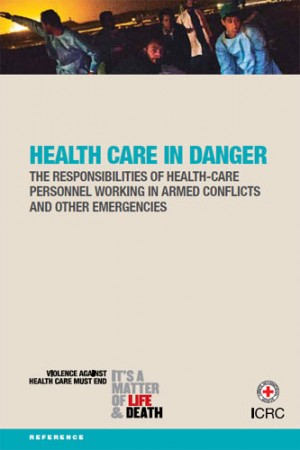
|
A Guidance Document in simple language for health personnel, setting out their rights and responsibilities in conflict and other situations of violence. It explains how responsibilities and rights for health personnel can be derived from international humanitarian law, human rights law and medical ethics. The document gives practical guidance on:
|
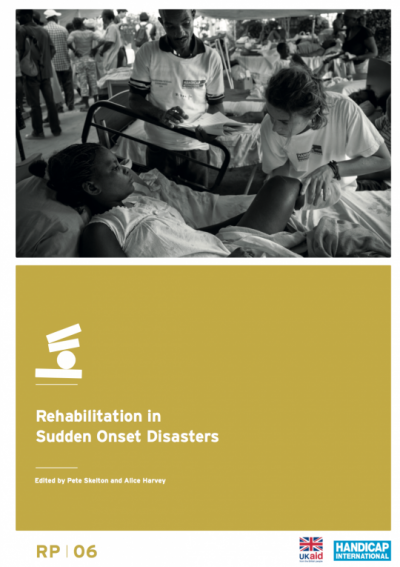
|
Rehabilitation in Sudden Onset Disasters. The role of rehabilitation professionals in responding to sudden onset disasters, such as earthquakes or tsunamis, is evolving rapidly, and they increasingly find themselves at the forefront of emergency response teams. This manual is designed for Physiotherapists and Occupational Therapists who provide rehabilitation in the immediate aftermath of a sudden onset disaster. It was developed to support volunteers on the UK International Emergency Trauma Register, but with the aim of being relevant to all rehabilitation professionals interested in rapid deployment to austere environments. |
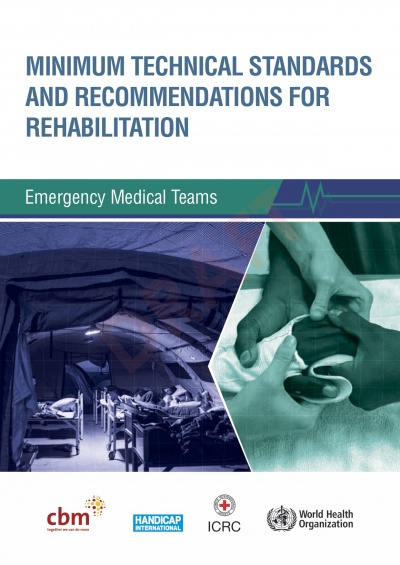
|
Minimum Technical Standards and Recommendations for Rehabilitation: Emergency Medical Teams This document is the result of collaboration between a working group of rehabilitation experts convened by WHO and external consultations. It is thus based on collective experience in rehabilitation during responses to recent large-scale emergencies and also on published data. In time, the minimum standards for rehabilitation in emergencies will be part of a broader series of publications based on the Classification and minimum standards for foreign medical teams in sudden onset disaster. The purpose of this document is to extend these standards for physical rehabilitation and provide guidance to Emergency Medical Teams (EMTs) on building or strengthening their capacity for and work in rehabilitation within defined coordination mechanisms.The standards and recommendations given in this document will ensure that EMTs, both national and international, will better prevent patient complications and ensuing impairment and ensure a continuum of care beyond their departure from the affected area. |
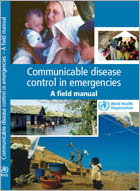
|
Communicable Disease Control in Emergencies - A Field Manual This manual is intended to help health professionals and public health coordinators working in emergency situations prevent, detect and control the major communicable diseases encountered by affected populations. |
Resources[edit | edit source]
The WCPT provide a comprehensive set of resources relating to disaster management, the role of the phsyiotherapy profession, advice for volunteering and the existing organisations involved:
Recent Related Research (from Pubmed)[edit | edit source]
Extension:RSS -- Error: Not a valid URL: Feed goes here!!|charset=UTF-8|short|max=10
References[edit | edit source]
- ↑ Elliott D. Disaster and Crisis Management. In The Handbook of Security 2014 (pp. 813-836). Palgrave Macmillan UK.
- ↑ International Federation of Red Cross & Red Crescent Societies. What is a Disaster. http://www.ifrc.org/en/what-we-do/disaster-management/about-disasters/what-is-a-disaster/. [Accessed: 9 Jan 2017]
- ↑ International Federation of Red Cross & Red Crescent Societies. What is a Disaster. http://www.ifrc.org/en/what-we-do/disaster-management/about-disasters/what-is-a-disaster/. [Accessed: 9 Jan 2017]
- ↑ Leaning J, Guha-Sapir D. Natural Disasters, Armed Conflict, and Public Health. New England Journal of Medicine. 2013 Nov 7;369(19):1836-42
- ↑ International Federation of Red Cross and Red Crescent Societies. Types of Disasters. http://www.ifrc.org/en/what-we-do/disaster-management/about-disasters/definition-of-hazard/. [Accessed: 02 Jan 2017]
- ↑ United Nations Office for Disaster Risk Reduction. Terminology. http://www.unisdr.org/we/inform/terminology#letter-p [Accessed 29 Nov 2016]
- ↑ International Federation of Red Cross and Red Crescent Socities. Complex/Manmade Hazards: Complex Emergencies. http://www.ifrc.org/en/what-we-do/disaster-management/about-disasters/definition-of-hazard/complex-emergencies/. [Accessed 18 Dec 2016]
- ↑ International Federation of Red Cross and Red Crescent Socities. Complex/Manmade Hazards: Complex Emergencies. http://www.ifrc.org/en/what-we-do/disaster-management/about-disasters/definition-of-hazard/complex-emergencies/. [Accessed 18 Dec 2016]
- ↑ WCPT. What is Disaster Management. http://www.wcpt.org/disaster-management/what-is-disaster-management. [Accessed 8 Jan 2017].
- ↑ Wikipedia. Pandemics. https://en.wikipedia.org/wiki/Pandemic. [Accessed: 3 Jan 2017]
- ↑ International Federation of Red Cross and Red Crescent Societies. About Disaster Management. http://www.ifrc.org/en/what-we-do/disaster-management/about-disaster-management/ [Accessed: 03 Jan 2017]
